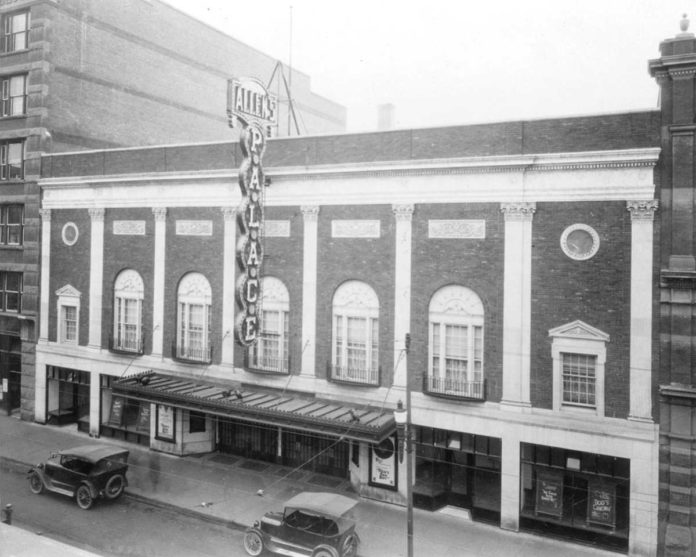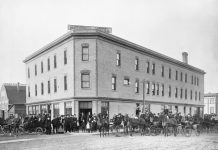219 8 Avenue SW
Information courtesy of the City of Calgary Inventory of Historic Resources.
This month, we’re going to take a look at the Palace Theatre. Located on Stephen Avenue, the theatre features opulent style and design and has been used for a variety of events since its construction in 1921. The Palace was designed by American architect Crane C. Howard, who specialized in the design of theatres; he designed over 250 movie palaces throughout his career. So, you may be wondering, what is a “movie palace”? It is, more or less, exactly what it sounds like. They were large, elaborate, fancy movie theatres that were very popular during this time period. These design choices were believed to be an attempt to portray films as acceptable forms of entertainment.
The Palace, which was designed in the Renaissance Revival style of architecture, was built during the post-World War One era, prior to the Stock Market Crash and eventual Depression. It was part of the first theatre chain in Canada, the Allen Theatres, which had a chain of almost 100 theatres. Allen Theatres had a movie palace in almost every Canadian city between 1917 and 1921. They had planned to expand to the United States and Britain; however, the stock market crash led to declining audiences and decreased funds, causing Allen Theatres to file for bankruptcy. The chain was sold in 1923.
Throughout its history, the Palace Theatre has had many different purposes. Obviously, it began as a movie palace. The Allen Theatres chain sold the theatre to Famous Players. They remained the owners until they permanently closed the theatre in 1990. In addition to screening films, the building was also used for radio broadcasting, and was home to the first public exhibition of radio in the city, which occurred in 1922. The 1,700-seat theatre was also the home to an evangelical broadcast. Beginning in November of 1925, William ‘Bible Bill’ Aberhart, Alberta’s first Social Credit Premier, would make Sunday afternoon broadcasts in the theatre, which continued for many years. The Palace also hosted benefit concerts for World War Two efforts, and flooding in Bowness and Sunnyside in the 1920s.
The theatre was also the primary venue for theatre and concert performances for over thirty years. This changed in 1956 when the Southern Alberta Jubilee Auditorium opened. In 1996, following its 1990 closure, the Palace Theatre was given a Notice of Intent to Designate, which allowed renovations and restoration to begin on the four-storey structure. This development had to ensure that the lavish interior remained as intact as possible, as the preservation and protection of the resource was in the public interest. With the help of the Stephen Avenue Heritage Society, the facade of the palace was restored, and the inside was altered, which allowed for the structure to become a nightclub and cigar lounge, which opened in 1998.
The Palace closed in 2004, and the building remained vacant until 2007. Then the building became Flames Central, which was a restaurant and bar, but also a nightclub and concert venue. Flames Central remained for roughly ten years before changing the name and rebranding. This rebrand, however, was more like a Back to the Future style change, as the building would once again be known as, you guessed it, The Palace Theatre. Personally, I like a full circle moment. Will The Palace Theatre remain The Palace Theatre? If history has taught us anything, the answer to that is likely no. However, it seems as if it is only ever a matter of time before the original name reigns again. Whether you’re heading there for a night out, a concert, or simply to take some pictures, I hope you’re able to go and check out this little piece of history in our downtown core!









